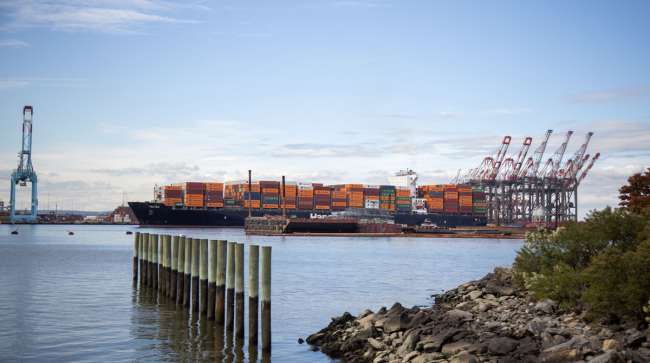Staff Reporter
Largest Strike in Decades Begins at East, Gulf Coast Ports

[Stay on top of transportation news: Get TTNews in your inbox.]
U.S. dockworkers at ports along the East and Gulf Coasts began their first major strike in decades Oct. 1 in a move that threatens to have downstream impacts on trucking.
The United States Maritime Alliance and the International Longshoremen’s Association had been negotiating a new master labor agreement throughout the summer. The deal would cover 45,000 unionized dockworkers at more than 30 container ports. But discussions between the sides have deteriorated into a labor strike.
“ILA longshore workers deserve to be compensated for the important work they do keeping American commerce moving and growing,” ILA leadership said in a statement. “[Foreign-owned shipping companies] want to make their billion-dollar profits at United States ports, and off the backs of American ILA longshore workers, and take those earnings out of this country.”
ILA accused port leadership of refusing to come to fair terms on wages and automation. The USMX has in turn filed an unfair labor practice complaint alleging that the union is not bargaining in good faith.
“In the short term, slowing import demand could leave more truckload supply [capacity] available to support relief efforts while the ports are closed,” said David Spencer, vice president of market intelligence at Arrive Logistics. “Additional challenges with sourcing much-needed building materials could build the longer a strike lasts due to the importance of the ports in supplying those materials, reducing product availability and causing rapid cost inflation.”
Spencer added that the strikes could also disrupt supply chains operations related to fresh foods, automotive parts, plastics and furniture. He believes the strike could ultimately become one of the most disruptive freight market events since the COVID-19 pandemic.

Hoexter
“Our base case is a port strike lasting no more than a few days or weeks before the Taft-Hartley Act is invoked to reopen the ports,” Bank of America analyst Ken Hoexter wrote in a report. “Freight forwarders [Expeditors International], and freight brokers [C.H. Robinson and RXO], which serve as middlemen between shippers and freight carriers, stand to benefit in a prolonged period of capacity disruption.”
The Conference Board found that a one-week strike could cost the U.S. economy $3.78 billion. The nonprofit business research organization said the ports handle 57% of container volume in the U.S. It also pointed out that the strike is happening at a critical time with the presidential election approaching.
A looming U.S. East Coast port strike would have severe consequences for food and many other farm products shipped from American farm and ranch families to international buyers. The latest #MarketIntel breaks it all down. https://t.co/acrXgS8e6j — American Farm Bureau (@FarmBureau) September 26, 2024
“A port strike would paralyze U.S. trade and raise prices at a time when consumers and businesses are starting to feel relief from inflation,” said Erin McLaughlin, senior economist at the Conference Board. “While shippers have already begun diverting some cargo to the West Coast, capacity for such alternative options is limited.”
Strike commences across US eastern seaboard https://t.co/RaJdjCjwOv — The ILA App (@TheILAmobileApp) October 1, 2024
Project44 noted in a report that the impacted ports represent roughly 50% of all imports and exports in the country during ocean peak season when retailers import goods for the holidays.
The Southeast is just beginning to dig out from historic and deadly flooding. Now is not the time to shut down 36 ports along the East and Gulf Coasts that could be an important part of recovery efforts. The Administration must get the parties to the table and reach a deal.… — American Trucking (@TRUCKINGdotORG) September 30, 2024
“While strikes themselves can be disruptive to everyday operations, considering how this latest strike compounds with other geopolitical and environmental disruptions is crucial,” said Margaret Selid, senior product marketing manager at Project44. “This latest strike comes on the heels of Hurricane Helene in the Southeast and a year of disruption in the Red Sea. We’re looking at only days before we start seeing the cost of goods go up.”

Selid
Selid added that the disruption is expected to impact holiday inventory and delivery estimates. She noted that some stores may even begin hiking prices in anticipation of shortages and delays and that the ripple effects of a multiday strike could last into 2025.
However, Proxima Vice President Spencer Shute said, “The labor strikes at East Coast and Gulf Coast ports are generating considerable discussion, but their actual impact on the supply chain for the peak holiday season may be less severe than anticipated. Most holiday merchandise is already in the U.S.”
Shute added that the immediate impact will likely be felt by manufacturers reliant on these ports for automotive and industrial production parts. He expects that the resiliency plans manufacturers implemented in the aftermath of the pandemic will be tested.

Shute
“With this strike underway, we can expect a surge in truckload capacity, particularly in the Gulf Coast and East Coast, which may temporarily lower rates as drivers adjust to meet demand,” Shute said. “Additionally, significant disruptions to agricultural exports could impact both domestic and global markets, affecting supply and prices.”
Shute added that ultimately, manufacturers need to adopt long-term strategies to navigate these disruptions.
“The biggest commodity impact for the East Coast in the near term is agriculture and fresh food products,” said Hamish Woodrow, head of strategic analytics at Motive. “While these strikes will increase congestion to ports on the West Coast, the other side of that coin is that those ports will profit from surcharging and increased local demand.”
Want more news? Listen to today's daily briefing below or go here for more info:




